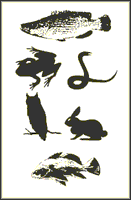Nebraska Cooperative Fish and Wildlife Research Unit

Nebraska Cooperative Fish and Wildlife Research Unit: Staff Publications
Date of this Version
8-4-2022
Citation
Arctic Science 8: 1082–1093 (2022) | dx.doi.org/10.1139/AS-2021-0030
Abstract
As marine ecosystems respond to climate change and other stressors, it is necessary to evaluate current and past hybridization events to gain insight on the outcomes and drivers of such events. Ancestral introgression within the gadids has been suggested to allow cod to inhabit a variety of habitats. Little attention has been given to contemporary hybridization, especially within cold-water-adapted cod (Boreogadus saida Lepechin, 1774 and Arctogadus glacialis Peters, 1872). We used whole-genome, restriction-site associated, and mitochondrial sequence data to explore the degree and direction of hybridization between these species where previous hybridization had not been reported. Although nearly identical morphologically at certain life stages, we detected very distinct nuclear and mitochondrial lineages. We detected one potential hybrid with a Arctogadus mitochondrial haplotype and Boreogadus nuclear genotype, but no early generational hybrids. The presence of a late generation hybrid suggests that at least some hybrids survive to maturity and reproduce. However, a historical introgression event could not be excluded. Contemporary gene flow appears asymmetrical from Arctogadus into Boreogadus, which may be due to overlap in timing of spawning, environmental heterogeneity, or differences in population size. This study provides important baseline information for the degree of potential hybridization between these species within Alaska marine environments.
Included in
Aquaculture and Fisheries Commons, Environmental Indicators and Impact Assessment Commons, Environmental Monitoring Commons, Natural Resource Economics Commons, Natural Resources and Conservation Commons, Water Resource Management Commons


Comments
Open access.